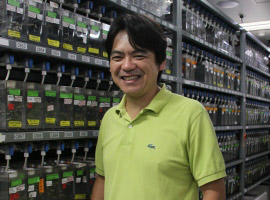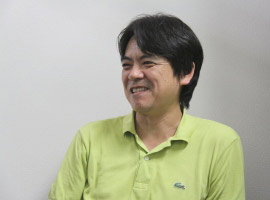KAWAKAMI, Koichi D. Sc., Professor

A researcher’s “labor pains” and joy of research
- Supplying transgenic zebrafish to laboratories all over the world
- “I suppose you’ve never set foot in a fish room,” Prof. Kawakami said to me as he led me to a room whose walls were lined with water tanks from the ceiling to the floor. It was a breathtaking view, with numerous zebrafish swimming in the tanks (see photo). “Here, there are about 1,000 strains of transgenic zebrafish. In one strain of zebrafish, for example, only their brains shine green, while those of another strain have a heart that shines green. I have developed the technology to produce transgenic fish that have such attributes exactly as desired. It’s taken me ten years to arrive at this stage.”
 In 1994, Dr. Kawakami switched his area of research from unicellular organisms to zebrafish following his stint at Massachusetts Institute of Technology. At that time, in Japan there were only a few scientists doing research with zebrafish. “It was a new model organism. So I chose it as if to bet my career on it. In zebrafish, the entire cellular organization in the process of embryonic development is visible, which is quite pleasing to the eyes.” Dr. Kawakami produces transgenic zebrafish to use for his group’s research and supply to research scientists all over the world for various research purposes. “I develop efficient transgenesis methods and supply zebrafish to the whole world, which help improve research including biomedical research. Although we are doing quite basic science, I’m glad I get to be useful to human beings in such an indirect manner,” said Dr. Kawakami.
In 1994, Dr. Kawakami switched his area of research from unicellular organisms to zebrafish following his stint at Massachusetts Institute of Technology. At that time, in Japan there were only a few scientists doing research with zebrafish. “It was a new model organism. So I chose it as if to bet my career on it. In zebrafish, the entire cellular organization in the process of embryonic development is visible, which is quite pleasing to the eyes.” Dr. Kawakami produces transgenic zebrafish to use for his group’s research and supply to research scientists all over the world for various research purposes. “I develop efficient transgenesis methods and supply zebrafish to the whole world, which help improve research including biomedical research. Although we are doing quite basic science, I’m glad I get to be useful to human beings in such an indirect manner,” said Dr. Kawakami.- An unforgettable moment
 “For four to five years after returning to Japan from the United States, I worked almost by myself, buying about 30 cheap plastic water tanks at a pet shop to raise zebrafish. The objective of my research was to get different parts of the zebrafish body to shine efficiently with the use of the protein called Green Fluorescent Protein (GFP). One day in 2001, I was looking at a zebrafish under a microscope and saw for the first time a part of its brain shining. I felt weak at the knees and said to myself, ‘I can make it!’ At that unforgettable moment, I was able to visualize myself operating a large fish room as I do now.” Dr. Kawakami gave me an unexpected answer when I asked if it had been hard to work on his own. “No, it’s quite convenient to work by yourself because you can control everything for yourself. You also try to find ingenious solutions to problems and focus only on what is absolutely necessary to make up for the lack of help. Your research will become sophisticated this way. Of course, your experimental skills must be very good.”
“For four to five years after returning to Japan from the United States, I worked almost by myself, buying about 30 cheap plastic water tanks at a pet shop to raise zebrafish. The objective of my research was to get different parts of the zebrafish body to shine efficiently with the use of the protein called Green Fluorescent Protein (GFP). One day in 2001, I was looking at a zebrafish under a microscope and saw for the first time a part of its brain shining. I felt weak at the knees and said to myself, ‘I can make it!’ At that unforgettable moment, I was able to visualize myself operating a large fish room as I do now.” Dr. Kawakami gave me an unexpected answer when I asked if it had been hard to work on his own. “No, it’s quite convenient to work by yourself because you can control everything for yourself. You also try to find ingenious solutions to problems and focus only on what is absolutely necessary to make up for the lack of help. Your research will become sophisticated this way. Of course, your experimental skills must be very good.”- Throes of creation
- Dr. Kawakami says that it is tough to be a research scientist. “Just like a writer or artist, you must suffer throes of creation to give birth to something new like research results. You must work from scratch on your own and must be strong enough to endure this difficulty. Others can’t tell you what to produce or how.” Moreover, he says that in biological research it takes a long while until scientists can take pleasure in their research. “In the beginning, you’re not very good at conducting experiments, and don’t really know what you’re doing. Namely, you can’t tell whether your experiments have gone wrong, or your idea was not quite right. You can enjoy your research only when you can be 100% sure about your experimental skills. So you just have to hang in there until you obtain your doctorate, thinking that all this is your training. If you’re aware of this, perhaps you’ll be better prepared.”
- (Interviewed by Yoshiko Tamura 2011)
Back

 In 1994, Dr. Kawakami switched his area of research from unicellular organisms to zebrafish following his stint at Massachusetts Institute of Technology. At that time, in Japan there were only a few scientists doing research with zebrafish. “It was a new model organism. So I chose it as if to bet my career on it. In zebrafish, the entire cellular organization in the process of embryonic development is visible, which is quite pleasing to the eyes.” Dr. Kawakami produces transgenic zebrafish to use for his group’s research and supply to research scientists all over the world for various research purposes. “I develop efficient transgenesis methods and supply zebrafish to the whole world, which help improve research including biomedical research. Although we are doing quite basic science, I’m glad I get to be useful to human beings in such an indirect manner,” said Dr. Kawakami.
In 1994, Dr. Kawakami switched his area of research from unicellular organisms to zebrafish following his stint at Massachusetts Institute of Technology. At that time, in Japan there were only a few scientists doing research with zebrafish. “It was a new model organism. So I chose it as if to bet my career on it. In zebrafish, the entire cellular organization in the process of embryonic development is visible, which is quite pleasing to the eyes.” Dr. Kawakami produces transgenic zebrafish to use for his group’s research and supply to research scientists all over the world for various research purposes. “I develop efficient transgenesis methods and supply zebrafish to the whole world, which help improve research including biomedical research. Although we are doing quite basic science, I’m glad I get to be useful to human beings in such an indirect manner,” said Dr. Kawakami. “For four to five years after returning to Japan from the United States, I worked almost by myself, buying about 30 cheap plastic water tanks at a pet shop to raise zebrafish. The objective of my research was to get different parts of the zebrafish body to shine efficiently with the use of the protein called Green Fluorescent Protein (GFP). One day in 2001, I was looking at a zebrafish under a microscope and saw for the first time a part of its brain shining. I felt weak at the knees and said to myself, ‘I can make it!’ At that unforgettable moment, I was able to visualize myself operating a large fish room as I do now.” Dr. Kawakami gave me an unexpected answer when I asked if it had been hard to work on his own. “No, it’s quite convenient to work by yourself because you can control everything for yourself. You also try to find ingenious solutions to problems and focus only on what is absolutely necessary to make up for the lack of help. Your research will become sophisticated this way. Of course, your experimental skills must be very good.”
“For four to five years after returning to Japan from the United States, I worked almost by myself, buying about 30 cheap plastic water tanks at a pet shop to raise zebrafish. The objective of my research was to get different parts of the zebrafish body to shine efficiently with the use of the protein called Green Fluorescent Protein (GFP). One day in 2001, I was looking at a zebrafish under a microscope and saw for the first time a part of its brain shining. I felt weak at the knees and said to myself, ‘I can make it!’ At that unforgettable moment, I was able to visualize myself operating a large fish room as I do now.” Dr. Kawakami gave me an unexpected answer when I asked if it had been hard to work on his own. “No, it’s quite convenient to work by yourself because you can control everything for yourself. You also try to find ingenious solutions to problems and focus only on what is absolutely necessary to make up for the lack of help. Your research will become sophisticated this way. Of course, your experimental skills must be very good.”














